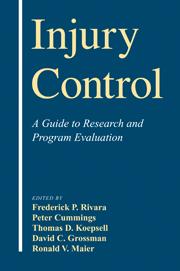Book contents
- Frontmatter
- Contents
- List of Contributors
- 1 An Overview of Injury Research
- 2 Classifying and Counting Injury
- 3 Measurement of Injury Severity and Co-morbidity
- 4 Data Linkages and Using Administrative and Secondary Databases
- 5 Rates, Rate Denominators, and Rate Comparisons
- 6 Data Collection Methods
- 7 Selecting a Study Design for Injury Research
- 8 Qualitative Methods in Injury Research
- 9 Randomized Trials
- 10 Cohort Studies in Injury Research
- 11 Case–Control Studies in Injury Research
- 12 Ecologic Studies
- 13 Case Series and Trauma Registries
- 14 Systematic Reviews of Injury Studies
- 15 Evaluating an Injury Intervention or Program
- 16 The Development of Clinical Decision Rules for Injury Care
- 17 Trauma Performance Improvement
- 18 Measuring Disability and Quality of Life Postinjury
- 19 Economic Evaluation of Injury Control
- 20 Ethical Issues
- Index
1 - An Overview of Injury Research
Published online by Cambridge University Press: 16 October 2009
- Frontmatter
- Contents
- List of Contributors
- 1 An Overview of Injury Research
- 2 Classifying and Counting Injury
- 3 Measurement of Injury Severity and Co-morbidity
- 4 Data Linkages and Using Administrative and Secondary Databases
- 5 Rates, Rate Denominators, and Rate Comparisons
- 6 Data Collection Methods
- 7 Selecting a Study Design for Injury Research
- 8 Qualitative Methods in Injury Research
- 9 Randomized Trials
- 10 Cohort Studies in Injury Research
- 11 Case–Control Studies in Injury Research
- 12 Ecologic Studies
- 13 Case Series and Trauma Registries
- 14 Systematic Reviews of Injury Studies
- 15 Evaluating an Injury Intervention or Program
- 16 The Development of Clinical Decision Rules for Injury Care
- 17 Trauma Performance Improvement
- 18 Measuring Disability and Quality of Life Postinjury
- 19 Economic Evaluation of Injury Control
- 20 Ethical Issues
- Index
Summary
Accomplishments of Injury Research and Control
During the twentieth century, deaths from infectious diseases have declined dramatically around the world, particularly in industrialized countries. The initial decline occurred due to improved sanitation and public health; more recently it has been due to antibiotics, vaccines, and an increasing emphasis on prevention. Deaths among humankind from injuries have also declined substantially, as shown in Figure 1.1, although the decrease is far less than that for infectious diseases (Baker et al., 1992).
This decline in injury deaths over the last century occurred due to three distinct factors. The first, and in some ways the most important in industrialized countries, has been a general reduction in the exposure to injury hazards as a byproduct of changes in occupations, safer transportation, better housing, and heating, and many other factors that accompanied industrialization. Some hazards such as horses have been replaced by others such as motor vehicles; however, far fewer people are involved in underground mining, smelting of steel, farming, logging, and other dangerous occupations today than there were 100, 50, or even 20 years ago. Building codes have made our homes safer; improvements in highway design and airplane technology have made our travel safer. Equivalent changes in the general environment and the basic application of public health have accounted for far more reduction in infectious disease morbidity and mortality than have antibiotics.
The second factor accounting for the change in injury mortality is more recent: reduction in the risk of dying once injured due to improved medical and surgical care. Much of this improvement in trauma care originated on the battlefield and subsequently moved into the civilian population.
Keywords
- Type
- Chapter
- Information
- Injury ControlA Guide to Research and Program Evaluation, pp. 1 - 14Publisher: Cambridge University PressPrint publication year: 2000

